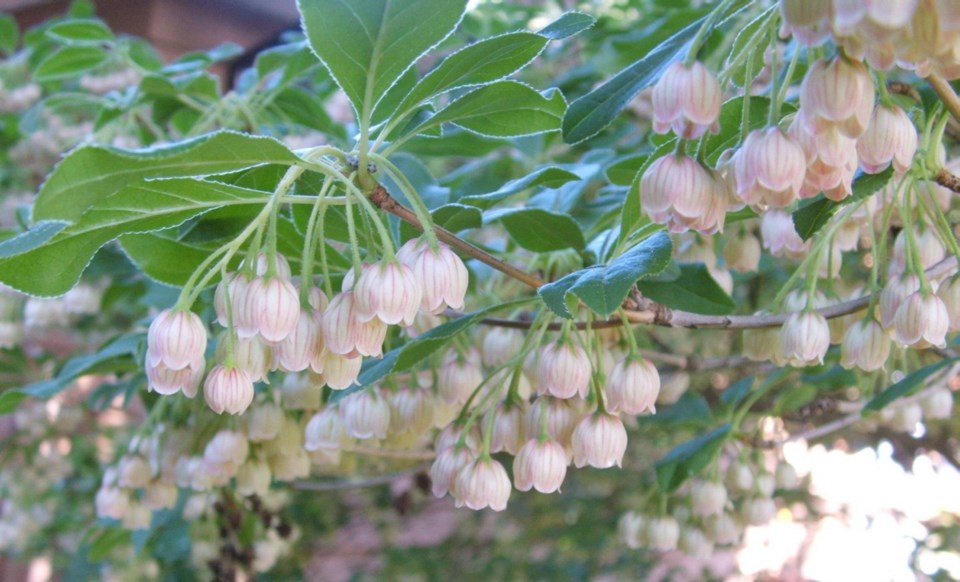There’s been much comment this spring on the earliness and unusually prolific bloom on fruiting and ornamental trees and shrubs. In my garden, it’s been most noticeable on the apple trees, blueberries, rhododendrons, an Enkianthus and a Choisya called Aztec Pearl. It’s almost as though last summer’s drought propelled the plants into procreative overdrive. May the fruit crops be as prolific as the flowers, and may we have a moderate and comfortable summer.
Innovative books. Several garden books that have come to my attention this spring have taken commonly treated topics and viewed them in new and useful ways.
Steve Solomon’s latest (2015) edition of Growing Vegetables West of the Cascades (Sasquatch Books) takes certain long-accepted gardening practices, questions them and supports his reasoning with scientific evidence. He challenges commonly held views on optimal use of compost and on preferred types of lime. And in his A to Z directory to growing vegetables he includes a note for each one on “dry gardening” that gives tips on reducing the planting’s need for watering.
The book carries forward the theme of a previous Solomon publication — The Intelligent Gardener: Growing Nutrient-Dense Food (New Society Publishers) —in its emphasis on re-mineralizing garden soils for an optimal balance of nutrients, which, in food gardens, translates into enhanced human health.
Along with nutrient density in foods comes flavour intensity. The more vivid the flavours in a vegetable or fruit, the higher its nutritional value is likely to be. Now, a newly published title further explores this theme in lively, entertaining fashion.
Grow for Flavor: Tips and Tricks to Supercharge the Flavor of Homegrown Harvests
By James Wong
Firefly Books, 224 pp, $29.95
This colourful and absorbing book is loaded on every page with unusual methods most of us will not have heard before, because many challenge traditional practices, particularly those related to watering, fertilizing and racing for high yields, that tend to water down flavours and nutrients.
The author, a Kew-trained botanist and science writer based in London, has personally trialled his growing systems, with further trials conducted at the Royal Horticultural Society garden in Wisely. The book bears the RHS logo.
He cites trials that demonstrate how cutting back on water at critical times helps to concentrate flavours and nutrients.
“Some Californian growers of premium tomatoes will stop irrigation altogether after the plants are established.” Known as “dry farming,” the method creates smaller plants and yields, along with “sky-rocketing” flavours. Even in beets and carrots, “lower irrigation can cause sugar content to rise, with nutritious polyphenols increasing by up to 86 per cent.”
Wong points out the importance of picking berries fully ripe, at their peak of fragrance and flavour. This may seem obvious, yet several times I’ve met gardeners who, for some mysterious reason, pick well ahead of full ripening.
The author recommends the use of seaweed fertilizer as a rich source of minerals and trace nutrients. Radicchio is considered a “fantastically healthy choice” for its concentration of phytonutrients. Several pages are devoted to the growing of sweet potatoes, including that crucial step of post-harvest curing for successful storage and full flavour.
Included in this attractive and captivating book is mushroom cultivation, a guide to salad greens, reasons for becoming a “seedling whisperer,” a visual guide to edible weeds, and unusual recipes that include a spiced pumpkin and carrot jam, baked zucchini chips, floral jams, and “Anthocyanin-Packed Blueberry pie.”
GARDEN EVENTS
Art in Bloom. The Mid Island Floral Art Club is staging a show titled Art in Bloom: A Kaleidoscope of Petals and Paint, Tuesday through Saturday, May 28, at The Old School House in Qualicum Beach, with an opening on Wednesday at 2 p.m. theoldschoolhouse.org.
Plant Identification and Culture. The next session in this monthly course is on Saturday, May 21, 1 to 4 p.m. Each session introduces 25 new plants, with their descriptions, preferred growing conditions, landscape uses and maintenance. This session will take the form of a Finnerty Gardens Field Trip. Information and registration at 250-479-6162. Cost to members per session is $35, others $45. Cost for 12 sessions: members $350, others $450. hcp.ca.



